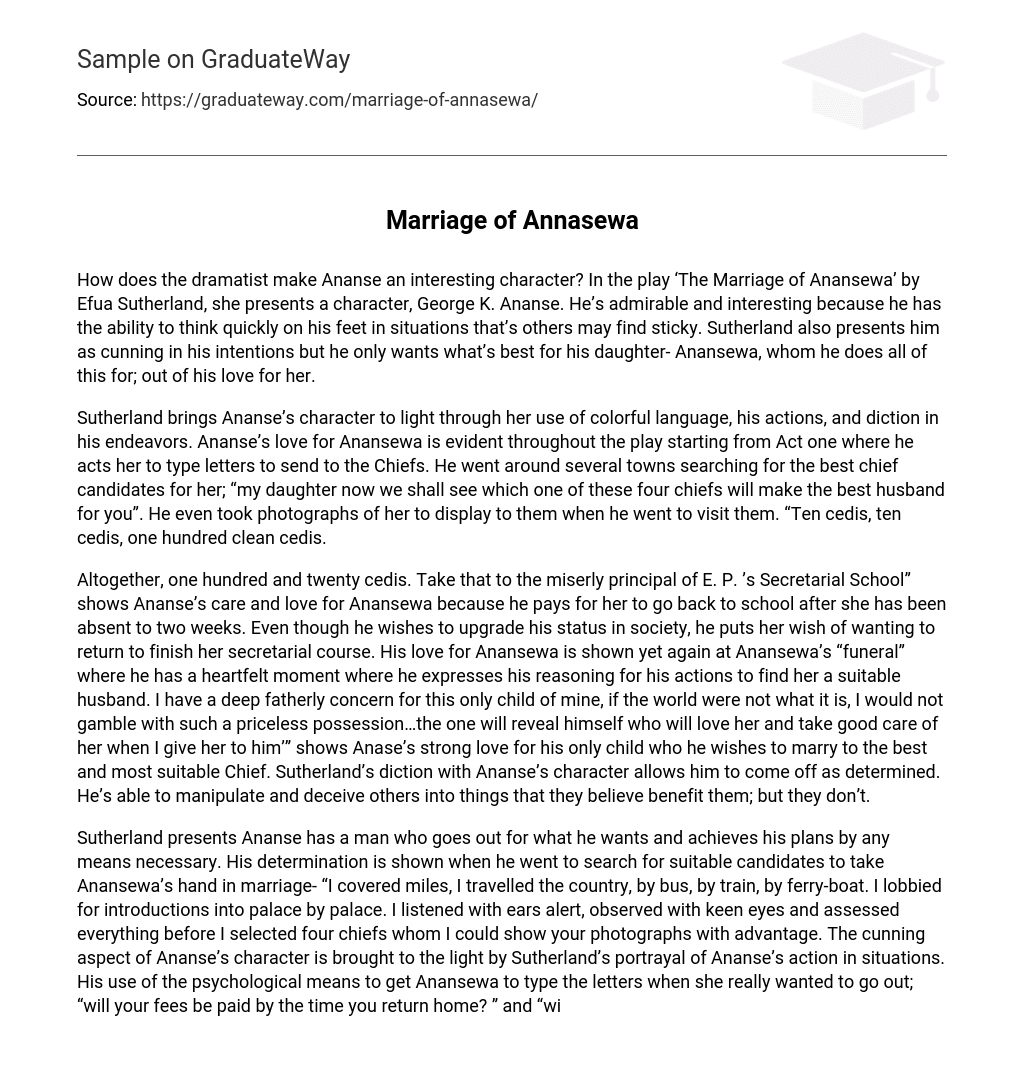In the play ‘The Marriage of Anansewa’ by Efua Sutherland, the dramatist portrays Ananse as an intriguing character through various techniques. Firstly, Ananse exhibits a remarkable ability to think swiftly in difficult situations, earning admiration from others. Furthermore, Sutherland depicts Ananse as cunning in his intentions; however, his actions are driven solely by his deep love for his daughter, Anansewa. It is this affection that motivates him to employ such tactics for the benefit of Anansewa.
Sutherland illuminates Ananse’s character by using vibrant language, showcasing his actions, and employing specific diction in his pursuits. Ananse’s deep affection for Anansewa is evident throughout the play, starting in Act One when he asks her to type letters to send to the Chiefs. He tirelessly travels to various towns in search of the most suitable chief candidates for her: “my daughter, now we will see which one of these four chiefs will be the best husband for you.” Ananse even takes photographs of her to present to the Chiefs during his visits. “Ten cedis, ten cedis, one hundred clean cedis.”
Ananse demonstrates his care and love for Anansewa by paying one hundred and twenty cedis to the principal of E. P. ’s Secretarial School, allowing her to return after a two-week absence. Despite his desire to upgrade his social status, he prioritizes Anansewa’s wish to finish her secretarial course. At Anansewa’s “funeral,” Ananse expresses his deep fatherly concern and explains his actions in finding her a suitable husband. He states, “I have a deep fatherly concern for this only child of mine… the one will reveal himself who will love her and take good care of her when I give her to him.” This illustrates Ananse’s intense love for his daughter and his desire to marry her off to the best and most suitable Chief. Sutherland’s diction portrays Ananse as determined, able to manipulate and deceive others into thinking they will benefit from his schemes when they actually won’t.
Sutherland depicts Ananse as a determined man who pursues his desires and achieves his goals by any means necessary. This determination is evident when he goes to great lengths to find suitable suitors for Anansewa’s hand in marriage, traveling the country via bus, train, and ferry-boat, seeking introductions into various palaces. He carefully selects four chiefs whom he believes would benefit from seeing her photographs. Sutherland also highlights Ananse’s cunning nature through his actions in certain situations. He psychologically manipulates Anansewa to type letters instead of going out by asking if her fees will be paid and if the leaking ceiling will be fixed by the time she returns home. By exerting power over her, he persuades her to do his bidding despite her own wishes.
The text highlights George’s character of deception and cunning. One example of this is when he deceitfully takes photos of Anansewa to bring along on his voyage. In order to execute his master scheme, he lies to his mother and aunt about their property being burnt down, tricking them into leaving the house. George’s quick thinking skills enable him to carry out his elaborate plan without fear of being discovered. Sutherland’s choice of words, such as “destroyers! Evil-doers!” reflects George’s belief that others will stop at nothing to ruin him.
George’s deception towards his mother and aunt, in order to deceive the chiefs, is demonstrated by enemies who appear friendly. George intends to carry out his scheme against the three chiefs, but doesn’t want his mother and aunt around, for he fears they would ruin his chances. He lies to them, saying “Someone has just reported to me that… that enemies have set fire to our hope. Our cocoa farm,” convincing them to leave and report to their land.





